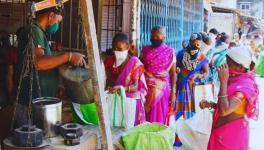RBI Paper Misinterpreting Reality, Kerala’s Public Spending Actually Fuelling Development, Say Experts

A study paper titled, ‘State Finances: A risk analysis' published in the Reserve Bank of India's (RBI) monthly newsletter has rung alarm bells over the financial status of a few states. The study was made at the outset of the crisis in Sri Lanka and has focussed on the financial status of the state governments and not of the country.
The report has identified five states to be highly stressed, namely Bihar, Kerala, Punjab, Rajasthan and West Bengal. The authors present the analysis based on fiscal vulnerability, debt sustainability and risk identification.
The finance minister of Kerala has rejected the observations made in the report as baseless while pointing out the lack of study on ground realities.
A major observation made in the analysis on the growth rate of the gross state domestic product (GSDP) being higher than the real rate of interest of the debt seems to be neglected while listing the state as highly stressed.
In the case, except Bihar, which is ruled by an ally of the Bharatiya Janata Party (BJP), the other four states are ruled by non-BJP parties demanding reconsideration of revenue share between states and centre.
The interpretation of revenue expenditure being high has been rejected since the state has a record of efficient spending. The notion of putting pensions, welfare measures and loan waivers as undesirable freebies based on the neo-liberal viewpoints has also attracted criticism.
REJECTING REALITIES
The state of Kerala has faced two devastating floods in 2018 and 2019, leading to massive destruction of infrastructure, not faced by any other states under study in the paper, which needed a massive infusion of funds by the state government. This was followed by the COVID-19 pandemic leading to a slowdown in the economy.
"Kerala has faced multiple strains during the recent years(2017-18 to 2021-22), including the floods and the pandemic. The implementation of the goods and sales tax (GST) and the seventh pay commission has also increased spending, while income has shrunk, which has not been considered by the authors," said Siddik Rabiyath, faculty of Economics at the University of Kerala.
The finance minister KN Balagopal was referring to these factors while rejecting the claims made in the report on the finances of the state. The factors leading to the reduction in income are not purely internal, including the implementation of the demonetisation, which choked the rural economy to a large extent.
The own tax revenue of the state increased until 2017-18, although marginally, but started to fall due to the implementation of GST and other spending needs.
"The central funds' transfer amounts to only 35%, while the state spends more from its own tax revenue. Only because of the intervention of the state government in crucial sectors like health and education, it excels in several human development indices (HDI),” Siddik said.
INCREASE IN DEVELOPMENTAL EXPENDITURE
The paper has pointed out that the revenue expenditure is high at 90.8% of the total expenditure, with the committed expenditure as a ratio of revenue expenditure being estimated at 38.8%. The authors have concluded that the share of developmental expenditure is considerably low.
Subin Dennis, a researcher with the Tricontinental Institute of Social Research, rejected the notion of categorising pensions as a non-development expenditure.
“Spending towards salaries for public education, public health and economic services are considered development expenditure, while the pensions are categorised as non-development expenditure,” he said.
The development expenditure of Kerala has increased and is high compared with the pre-COVID-19 period.
“The government of Kerala has created around 15,000 to 17,000 jobs in the health sector, along with the increase in allocation for higher education facilities. The state has made rapid strides on these sectors, which are not being considered by the authors,” said Siddik.
While pointing to the increasing spending on infrastructural development and other key areas, Siddik said, “You cannot disjoint development and expenditure. The state is developing on multiple fronts only because of the increase in spending. It's quite natural for the committed expenditure to go up.”
Branding extending welfare measures, including cash transfers, farm loan waivers and interest-free loans, as undesirable freebies have invited wrath.
“This is a deeply flawed and neo-liberal view. Many political parties have been demanding more cash transfers and interest-free loans to overcome the impact of the pandemic, which is absolutely necessary,” Subin said.
Referring to the subsidies and freebies, Siddik noted that the steps taken by the Left and Democratic Front (LDF) government in Kerala excelled in keeping its population hunger-free throughout the pandemic.
"Every single household was a beneficiary of the food kites distributed, which saved the population from starving. The government has done its duty to save its people, for which you need to spend money. Categorising this as freebies or subsidies cannot be accepted," he said.
IMBALANCE BETWEEN CENTRE AND STATE SPENDING
The imbalance of income and expenditure between the states and union government has neither been considered in the paper before drawing conclusions on debts and deficits.
“As per the 15th finance commission report, 62.7% of the total receipt goes to the union government, while 62.4% of the expenditure commitments are borne by the state governments. This has been exacerbated by the implementation of the GST, leaving the states with limited powers to set tax,” Subin said.
The authors have listed Kerala, Rajasthan and West Bengal as surpassing the 15th finance commission's targets for debt and fiscal deficit in 2022-23.
"Had Kerala not suffered from the impacts of the floods and pandemic, the revenues would have been higher. The contractionary policies followed by the Union government also affected the growth prospects of the states. Much greater devolution of funds to the states is essential to redress the financial stress," said Subin.
Despite all the limitations, the state of Kerala is moving ahead with developmental activities which are highly appreciated and recognised by the government of India.
“The question of sustainability and vulnerability hyped in the paper is not a concern as Kerala is marching ahead and is not staying behind. Several indices of the state are on par with developed countries only due to public spending, which the state must continue to do,” Siddik said.
He also took exception to the decision of the RBI to publish the paper in its newsletter, on which many depend for firsthand information.
"The paper tries to vindicate the state for the economic stress instead of focussing on the policies pursued by the union government. The further actual data being misinterpreted based on the neo-liberal policies warranting states to stay away from spending is illogical. You cannot stop spending on essentials from reducing the debt', said Siddik.
Get the latest reports & analysis with people's perspective on Protests, movements & deep analytical videos, discussions of the current affairs in your Telegram app. Subscribe to NewsClick's Telegram channel & get Real-Time updates on stories, as they get published on our website.
























